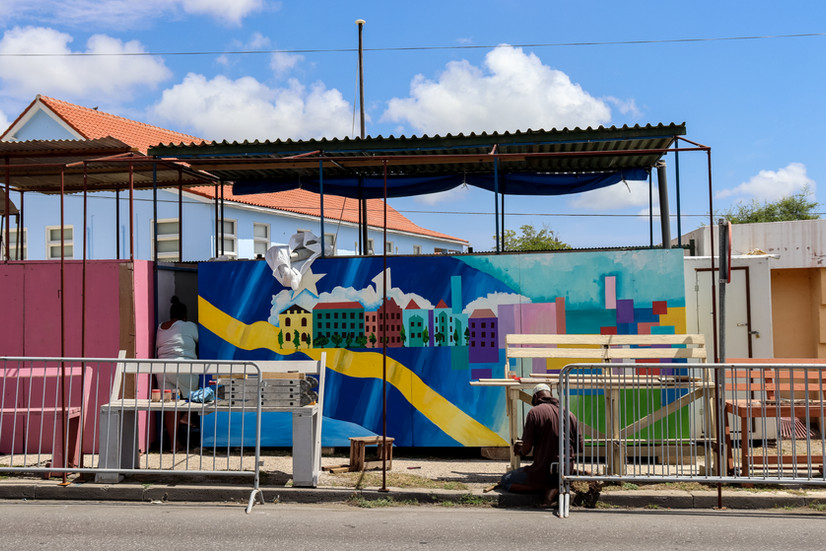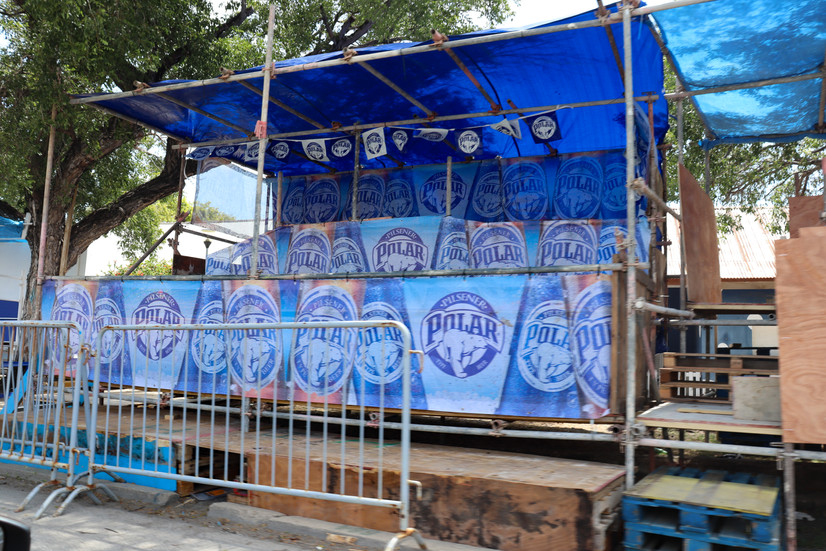Shade, sounds and self-built stands: the impact of temporary use along Curaçao's carnival route
- Krea
- Feb 28
- 4 min read
Updated: Mar 1

Carnival season in Curaçao is in full swing! Look around and you will see many of the temporary structures, or locally more known as “stands”’, that arise along the carnival parade route. When thinking of carnival in Curaçao, often its vibrant culture, tumba music, and colorful costumes come to mind. Yet, another striking feature of this annual event is its temporary use of public spaces along the parade route. During the carnival period, decorated wooden constructions, chairs, and metal bleacher seatings take up sidewalks to provide spectators with a space to watch and enjoy the various carnival parades.
Unlike in many other Latin America or Caribbean countries that celebrate carnival and where such stands are provided by the government, here in Curaçao, the stands are self-built by individuals, families, and companies that have obtained the necessary permits (“prekario”). It gives the local community an active role in creating an attractive atmosphere along the carnival route.

A social gathering
Curaçao’s approach to allow individuals, groups, or businesses to set up their own stands provides a decentralized and community-driven experience. This system gives residents and companies an opportunity to participate directly in the carnival activities by building stands to enjoy with family and friends, or commercially by selling tickets to spectators. While this allows for greater flexibility and community involvement, it also requires strict regulation with regard to permits, safety, and order.
The actual construction of the stands in the weeks leading up to the parades is accompanied by social activities in the form of roadside barbeques, domino playing, and cozy gatherings. Family, friends, and co-workers all give a helping hand; whether it’s with construction, cooking, decorating, building materials, or transportation. People are also walking along the road of the structures to visit their neighbors or they are driving (slowly) by car to get a taste of the preparations and to see the temporary structures in development.
Working together to finish the stands.
The use of the stands throughout this period transforms the carnival route, from Santa Maria to the historic city district of Otrobanda, into a temporary destination. Each area is known to have its own atmosphere and nicknames are given to the areas to describe their locations (often using specific landmarks like the “viaduct” or “roundabout”).
Even though the self-built stands have many positive social effects, they can be limiting too. If you don’t acquire a permit for a stand, don’t know anyone with a stand or don’t have the financial means to pay for a spot on a stand, then the options for comfortably watching the carnival parades are limited.
Creativity, practicality and self-expression
Temporary use refers to the temporary activation of empty or underused land with no immediate development demand [1]. Because of this characteristic, temporary uses have the ability to transform ordinary, underutilised public spaces into experimental areas where community members can play a role in shaping its urban environment.
From a technical standpoint, this unique form of self-building stands is part of a wider self-built architecture culture on the island, reflecting the island’s creativity, resourcefulness, and sense of local identity. In many cases, the structures are assembled from materials that may be readily available or repurposed, such as wood, metal, tarp and other low-cost and durable elements, leading to often simple but functional stands. Reusability of the components is also often an important aspect of the design. Modern additions include wi-fi, air conditioning, and portable toilets. Each unique stand must comply with regulations that ensure structural integrity, fire safety, and proper access, with the self-built approach adding complexity to these requirements.
Various creative and functional stands in the making.
Watching the parades is the main purpose, but protection from the sunny- and occasionally rainy- weather conditions is a close second priority. Completing the top three priorities is the appearance and expression of the stand itself. Colors, decorations, paintings, and messages give each stand a distinct look and feel, something the stand owners or users take pride in. Some stands might even have a different theme every year.
Sayings, song lyrics, or statements are often painted on the stands, showcasing a personal touch or sharing a message with the public.
The urban landscape also temporarily transforms. Roads, sidewalks, public spaces and buildings must adjust to accommodate the temporary installation of the stands, which can disrupt views, regular traffic flow and pedestrian movement during and after construction. Fortunately, the government has put measures in place to ensure that the stands are removed promptly after the event, leaving the area clean and ready for regular use.

Economic spin-off
The temporary stands enable local businesses, families and entrepreneurs to participate in the economic activities around carnival. Aside from commercial stands selling tickets to spectators, stands are also built to sell food and beverages. Companies play into the self-built stands as a way to promote their business or products with brand names and logos appearing all along the carnival route. These activities can be regarded as a temporary commercialisation of public space [2]. The construction, rental and logistics of the temporary stands also benefit a wide range of suppliers such as hardware stores, retail, catering, security and cleaning services.
A stand for selling food (left) and brands using stands as a way to promote their products (right).
Best carnival stand?
In conclusion, the stands in Curaçao are more than just temporary viewing platforms for carnival; they are an expression of the island's creativity and architectural self-built style. This phenomenon is a reflection of how temporary uses help strengthen the social fabric of the community and the opportunities that arise when public spaces are transformed for temporary events.
Every year there are awards for the best tumba songs and best carnival groups. Let’s introduce one for the best self-built carnival stand! To further stimulate creativity and as a recognition of its social, technical and economic values. So, tell us, which is your favorite carnival stand this year?

Sources
[1] Lehtovuori, Panu & Ruoppila, Sampo. (2012). Temporary uses as means of experimental urban planning. SAJ - Serbian Architectural Journal. 4. 29-53. 10.5937/SAJ1201029L.
[2] Smith, A., Vodicka, G., Colombo, A., Lindstrom, K.N., McGillivray, D. and Quinn, B. (2021), "Staging city events in public spaces: an urban design perspective", International Journal of Event and Festival Management, Vol. 12 No. 2, pp. 224-239.




















Comments